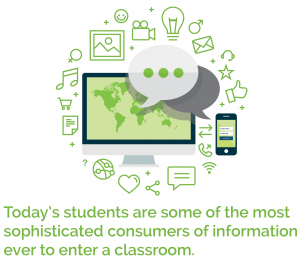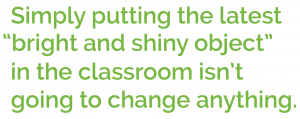This article by Odigia CEO and co-founder Joshua Moe was originally published by NISOD as an Innovation Abstracts on February 16, 2017. It is not to be edited or repurposed.
In the early 2000s, my job as an IT professional in higher education was to support the technology needs of the faculty, staff, and administrators on my campus. Time and again, I saw that the technological tools teachers had to work with didn’t suit the everyday, practical needs they faced in the classroom.
I began to ask the same questions to my peers on campus, and later on other campuses, public and private:
- What does technology do to help teachers teach and students learn?
- Is technology actually improving student outcomes?
- Is technology helping teachers to better prepare students for success in the 21st-century workplace?
The most common response to these questions was a blank stare, and when I did receive answers, they weren’t good.
I came to the conclusion that the learning management systems (LMS) that have pervaded institutions over the past few decades were not designed to move us forward in the quest to modernize education for the 21st century. LMS do a great job with certain reporting and administrative needs, but the user experience really just digitizes an outdated pedagogical model that doesn’t keep pace with what today’s students need to succeed.
Today, institutions and faculty require a digital learning tool that:
- Aims to make the learning experience more engaging and immersive for teachers and learners;
- Provides teachers with better data and new kinds of control over their content; and
- Helps students gain important soft skills such as critical thinking, problem solving, communication, and collaboration.
Educational technology should help address the broader goal of helping institutions better serve their students, and putting tools in the hands of educators in order to prepare students for success in today’s world. The lessons I’ve learned in my conversations with educators all over the country have implications for any institution trying to boost retention, lower students’ costs, and empower graduates to face the ever-changing challenges of the modern economy.
Retention Demands Engagement
Boosting retention and graduation rates is an important goal for many community and technical institutions. A 2016 report from the American Association of Community Colleges found that just over 38 percent of students who begin a course of study at a two-year public institution complete a degree after six years. While some students continue classes, fewer than half of those original students are still enrolled: they have left the institutions without achieving their goals.
Many different factors influence retention rates at community colleges. The improving economy has sent enrollment down for the past several years. Tuition and textbook costs can also be a barrier. Student diversity at these institutions—from full-time to part-time learners who also hold down various levels of employment and household responsibilities—adds to the retention challenge.
Facing these challenges makes it vital that institutions offer a learning experience that is dynamic and highly engaging, an experience that empowers students to take some level of control over how they interact with course content. Community colleges have to capture students’ interest and hold onto it in a way that clearly communicates that this investment of their time and money will pay off in the form of success in the workforce. Students must see a direct link between the knowledge they are receiving and their ultimate goals.
It’s easy to look at educational technology as a simple slam-dunk for student engagement, but simply putting the latest “bright and shiny object” in the classroom isn’t going to change anything. Furthermore, anyone who thinks that technology can replace the role of good teachers is in very dangerous territory. Based on my experience, I believe certain factors such as real-time data, a dynamic user experience, and options that can lower student costs can lead to the kind of student engagement that boosts community college retention rates.
Providing Real-Time Performance Data
Traditional assessment tools such as standardized tests only provide post-mortem data. Teachers need data that allow them to assess student performance in real time so they can make appropriate course corrections in a sensible fashion. In a 2005 article for the Journal of Education for Students Placed at Risk, education consultant Jeffrey Wayman notes that “schools have been ‘data rich’ for years,” but “information poor,” because the vast amounts of available data these institutions have are often stored in ways that are inaccessible to most practitioners. Easy access to this information is essential.
By combining the best of instructional design theory and data-driven decision-making technology, an educational platform can help teachers deliver better learning experiences and produce more actionable, real-time metrics. For instance, rather than looking at students’ performance individually—as in a traditional gradebook—teachers should have access to high-level perspectives that offer the ability to drill down into the specifics of how students are performing. This means measuring students’ time spent reading and viewing content and time spent completing formative assessments, as well as performance on those assessments.
While evaluating students, teachers should also have access to tools they can use to evaluate course content. Well-designed assessments placed after each course concept can help teachers see which concepts students are struggling with, and help teachers make adjustments that will benefit current and future students.
Creating an Immersive, Engaging Experience
Today’s students are some of the most sophisticated consumers of information ever to enter a  classroom. They need a learning experience that matches the interactive, individualized environment they encounter every day online. In addition, research over the past few decades has given us a much clearer picture of the various learning styles exhibited by students in a single classroom. The challenge, then, is to build a learning environment that includes the engaging functionalities of modern e-commerce, gaming, and social media, while also allowing students to personalize the learning experience to best meet their needs.
classroom. They need a learning experience that matches the interactive, individualized environment they encounter every day online. In addition, research over the past few decades has given us a much clearer picture of the various learning styles exhibited by students in a single classroom. The challenge, then, is to build a learning environment that includes the engaging functionalities of modern e-commerce, gaming, and social media, while also allowing students to personalize the learning experience to best meet their needs.
The following approaches are extremely helpful in engaging students:
- Allow students to access content in the sequence they choose: replay lectures, point out connections between different course concepts, and attach relevant supporting information found online.
- Use game-theory-based tools such as progress bars to indicate progress and completion, which motivates students to move through content. To encourage students to efficiently manage their time so they don’t fall behind, allow students to see exactly what activities they need to complete and how their progress compares with the class average.
- Make discussion easy and dynamic. The first key to accomplishing this is to ensure the discussion forum is highly visible and easy to use. Added features like flagging, favoriting, and filtering posts foster active collaboration among students that can bridge the gap between the classroom and independent study.
Reducing Costs
Rising textbook prices are a growing concern for students. A 2016 study found that half of community college students had used financial aid to pay for textbooks. High costs can, at times, cause students to forgo buying books altogether. This is not a recipe for effective learning.
Open educational resources (OERs) are freely accessible, openly licensed materials. Many institutions make it a priority to adopt OER course materials in an effort to bring down textbook costs. This can create confusion and extra work for faculty who have the additional challenges of first finding the best OERs for their class and then providing them in a manner that’s in the best interest of students.
It is my experience that OERs have great potential, but institutions must make the effort to adopt them within a well-designed user experience so they don’t become just a digitized version of a textbook. For many students, a traditional (and expensive) textbook is a lot easier to use than a PDF or digital version of the same text. The content must be reformatted so it’s suitable for digital presentation. For instance, digital content like OERs can be broken into smaller concepts that students can digest within a 15-20 minute session, versus the longer chapters found in traditional textbooks. A truly interactive platform can allow students to organize and interact with these smaller concepts in a sequence that makes sense to them, creating a more personalized experience. It’s also important to build in frequent formative assessments that allow students and teachers to see which concepts have been mastered and which are proving more difficult.
If done right, the adoption of OERs has the potential to reduce student spending on course materials by up to 90 percent. These savings can result in students enrolling in more classes per semester and make them more likely to return for classes the next semester.
Students’ Learning Needs Have Changed
Today’s students enter a world vastly different from what existed even five or ten years ago. Employees now need the ability to acquire new skills throughout their careers, as new technologies, jobs, and needs enter the marketplace. From social media pioneers to academics, many people observing education today are sounding alarm bells that the current system isn’t getting the job done.
 Today’s educators need tools that convey course content in a way that also equips students to be lifelong learners, or to “learn how to learn.” This ability comes with the engagement functionalities and personalization discussed above; however, learning experiences should also foster soft skills that today’s employers are looking for: critical thinking, problem solving, communication, and collaboration. One of the most important ways to foster soft skills is to encourage non-linear thinking. True mastery of a concept comes when students can apply it across different disciplines, and this process encourages the kind of problem solving and critical thinking that is crucial in the knowledge economy.
Today’s educators need tools that convey course content in a way that also equips students to be lifelong learners, or to “learn how to learn.” This ability comes with the engagement functionalities and personalization discussed above; however, learning experiences should also foster soft skills that today’s employers are looking for: critical thinking, problem solving, communication, and collaboration. One of the most important ways to foster soft skills is to encourage non-linear thinking. True mastery of a concept comes when students can apply it across different disciplines, and this process encourages the kind of problem solving and critical thinking that is crucial in the knowledge economy.
All of these goals—boosting engagement, providing better data to teachers, reducing costs for students, and building the skills necessary for today’s workforce—are achievable with technology solutions built with special attention to the specific needs of teachers and students. By staying focused on exactly what teachers need to do their jobs better and more efficiently, we can create an educational model that fits the needs of 21st-century learners.
What technological components do you rely on to engage and motivate students? Share your ideas with us in the comments section or on Facebook!
Joshua Moe, Co-Founder and CEO, Odigia


